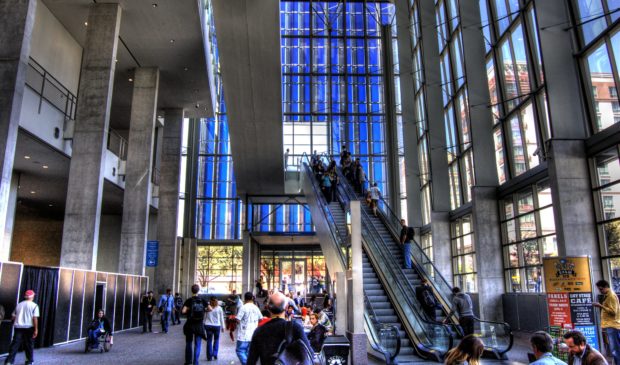Industry expert pokes holes in city’s convention center expansion plan
Thursday, February 24, 2022 by
Chad Swiatecki A presentation to the Downtown Commission last week largely refuted the need to expand the Austin Convention Center. Commissioners will revisit the issue at their March meeting.
The proposed expansion has been an issue for the commission since last fall when it formed a working group to gather information on the project that would likely cost more than $1 billion and would close all or parts of the facility for four years.
Commissioner Laura Templeton suggested at a recent Tourism Commission meeting that the Downtown Commission was planning this month to ask City Council to pull back from the expansion plans for two years to study the changing state of the convention industry following the Covid-19 pandemic. The Tourism Commission voted at that meeting to ask city staff to present updated business forecast and financing plans for the expansion at its March meeting.
The presentation from Heywood Sanders, professor of public administration at the University of Texas-San Antonio and an expert on convention centers, examined the expectations and realities of the 2002 convention center expansion and the business environment for facilities across the country for event bookings.
Sanders pointed out repeatedly that the 1997 forecast for the most recent expansion would more than double the annual number of hotel room nights generated by convention center business, one of the key business metrics for expansion proposals along with total event attendance.
While attendance figures for the convention center had been strong before the pandemic, Sanders said the predictions for hotel room nights have never been realized because popular events such as South by Southwest and DreamHack Austin have large turnouts made up of many day trippers who opt not to stay in hotels.
According to data from 2018, SXSW had attendance of more than 200,000 people but generated only 53,681 room nights. The next highest room night total that year was 14,462 for an immunology industry event.
Sanders said other than the major convention hubs of Chicago, Las Vegas, Atlanta and Orlando, convention centers across the country are fighting each other with room and rental discounts for bookings that haven’t kept up with expansion plans. And business for those cities had stayed flat for more than 20 years through 2019 even though all four had expanded their facilities’ square footage by 61 percent in total.
“Over that period there is no necessary relationship between expanding a center and getting more business over the cities, and those that have expanded existing centers have seen the same attendance they used to have,” Sanders said, adding that Philadelphia expected an expansion to grow its annual room nights from 503,000 to 786,000 but instead saw a decrease to about 380,000 in 2019.
Sanders also said arguments over lost business because of lack of space put forth by groups such as Visit Austin are overstated because bids made for events that aren’t a potential fit for the Austin facility can be counted as a missed opportunity.
“If someone walks into a car dealership, either in person or virtually, and walks out without buying a car, it’s the same thing and can be counted as lost business,” he said. “Every single convention center in this country has lost business, and no matter how big or how small they are, is there any research that documents that expanding a convention center allows you to attract a significant fraction of that lost business? The answer is no.”
Commissioners said Sanders’ presentation created questions they think city staffers and convention center stakeholders should consider while planning for the future of the facility.
“The past only gives us some amount of guidance, but you’re showing us where current trends are,” Commissioner Ben Heimsath said. “Is this a matter of Austin deciding that for the foreseeable future its convention center investment is sufficient and we should assume that it was already going to continue to serve the city and its needs without further major reprogramming?”
“I’m trying to piece together what the critical policy point is from our perspective.”
Photo made available through a Creative Commons license.
The Austin Monitor’s work is made possible by donations from the community. Though our reporting covers donors from time to time, we are careful to keep business and editorial efforts separate while maintaining transparency. A complete list of donors is available here, and our code of ethics is explained here.
You're a community leader
And we’re honored you look to us for serious, in-depth news. You know a strong community needs local and dedicated watchdog reporting. We’re here for you and that won’t change. Now will you take the powerful next step and support our nonprofit news organization?








